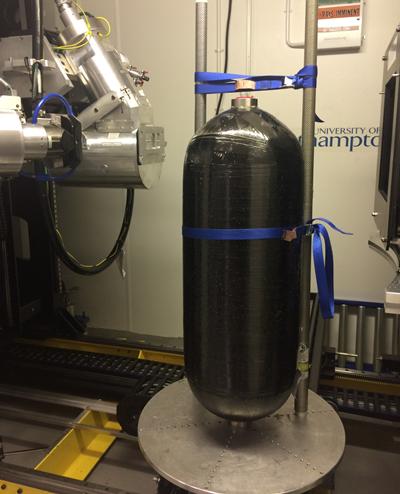Jan Rojek1, Sébastien Joannès1, Mark Mavrogordato2, Lucien Laiarinandrasana1, Anthony Bunsell1 and Alain Thionnet1,3
1 MINES ParisTech, PSL Research University, MAT – Centre des Matériaux, CNRS UMR 7633, BP 87, 91003 Evry, France
2 Faculty of Engineering and the Environment, University of Southampton, Southampton SO17 1BJ, United Kingdom
3 Université de Bourgogne, Mirande, BP 47870, 21078 Dijon, France
Background
Filament winding process used in manufacturing fibre-reinforced composite pressure vessels is known to lead to some microstructural variability. In particular, presence of voids has been reported. The knowledge of composite material microstructure is of great importance for accurate modelling of damage development and failure. In the present study, a thick 40-litre carbon fibre pressure vessel was scanned to observe and characterize porosity. In order to preserve the structure for future pressurization testing, it was necessary to perform the scans on a complete structure. This presented a technical challenge due to its significant dimensions and thickness.
Role of Computed Tomography
The tomography images allowed characterizing the composite stacking sequence and revealed the presence of intra- and interlaminar porosity. To observe the structure in more detail, a higher resolution scan was also carried out locally. The images showed a dependence of porosity on composite ply orientation as well as through-thickness position. Damage was observed in the inner hoop layer in the form of circumferential transverse cracks. The CT results were used to feed a multiscale numerical model for pressure vessel strength, accounting for the variation in mechanical properties due to the presence of porosity. Fibre break and matrix cracking phenomena were further taken into account. This gave a deeper insight into damage development mechanisms in composite pressure vessels.
Acknowledgements
The research leading to these results has been done within the framework of the FiBreMoD project and has received funding from the European Union’s Horizon 2020 research and innovation programme under the Marie Skłodowska-Curie grant agreement No 722626. The pressure vessel for the study was kindly supplied by Luxfer Gas Cylinders.
Figure 1 - Pressure vessel inside the HUTCH
Figure 2 - Porosity in a carbon fibre-reinforced composite: sum projection through 0.9 mm thickness

